Performance ceramic bearings have an enemy: grease. Grease lubricant is the most commonly used type of lubricant in the cycling industry because it provides consistent lubrication over a long period of time with little to no maintenance. However, ceramic bearings do not perform well when lubricated with grease lubricant. The added drag that ceramic has to overcome through grease that steel does not completely negates the wattage gains when all other factors are equal.
So, how do ceramic manufacturers get around this? There are two possible solutions. First, you could run your bearings dry. The smoother, harder surfaces of ceramic bearings do allow them to run dry when used in the right conditions. However, cycling is not one of these conditions. Dry running bearings are used in industrial applications where there is very little load placed on them. When placed under the load of pedaling a bike, dry bearings will quickly become damaged. Ceramic bearing manufacturers take the remaining path, which is light oil. Light oil lubricants allow the ceramic bearings to glide smoothly without the damage or running dry or the resistance of grease. However, this comes at a cost. First, light oil needs to be regularly checked and replaced. If the oil isn’t just right in the bearing, the balls will wear, which means they need to be smoothed out and repacked. This maintenance comes at a steep financial cost for most riders who rely on paying local bike shops to service their bikes. In addition, ceramic bearings can’t be sealed due to the need for regular maintenance. This leaves the bearing vulnerable to contaminants, which can damage the bearing and reduce performance.






